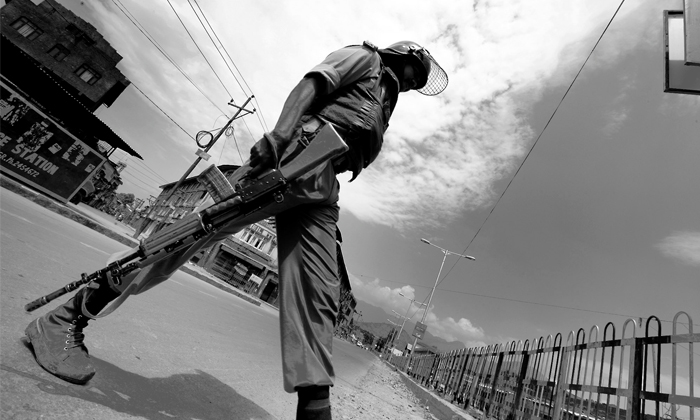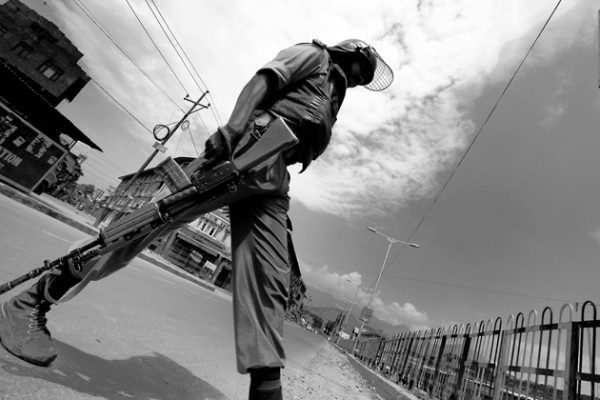On a sunny day in the summer of mid nineties, I was cycling to my school. After a few kilometers from home, I was stopped by CRPF troops stationed near one of the bunkers on a street in Srinagar. They asked me to open the school bag. One of the CRPF trooper, without touching the bag, thrust the nozzle of his gun inside the bag. Except for some text books, few notebooks, a geometry box and a lunch box, he found nothing inside. I was allowed to move on. After rearranging my books and some pages of notebooks disturbed by the nozzle of the gun, I started cycling again, slowly this time.
I missed the Morning Prayer session. Nothing interested me in school that day. I was indifferent in the class and mostly kept to myself. The lunchbox remained unopened. And after school I took a different, longer route back to my home.
I was a college student in the winter of 2004. On a cold December day I was waiting inside the exam hall to receive my science question paper for my annual grad exams. Suddenly, we heard some commotion from inside the hall. Urgent steps accompanied by the metallic sound of chains striking against each other. At the entrance of the hall, a young man with a trimmed beard made a dramatic appearance. He was in chains, surrounded by armed CRPF personnel and policemen. For sometime everyone looked up from their respective answer sheets. Accompanied by the CRPF troops and some policemen, he was brought inside the campus in an armed vehicle. Athletically built, he was wearing a brown jacket over a white khan dress. He wore a cheerful smile that stayed on his face even when he was chained. He looked a little older than us, probably in his mid twenties. Far from the resigned look of a condemned prisoner, he radiated the demeanour of a young scholar.
“Why did he not turn up today? Was he not allowed to sit in the exam? Was he supposed to make an appearance in the court today?”
The policemen unlocked his chains and allowed him to step inside the hall. He did not exchange a word with anyone and quietly occupied a bench in one corner of the hall. The examiner placed a question paper on his bench. He quietly began to write on the answer sheets without wasting any time. Unlike many students in the hall, who looked worried and anxious to recall the right answers, he seemed calm and composed, rarely lifting his head from his answer sheets. For once, every student had a long and hard look at him. These were the looks of awe and admiration. Outside the hall, the CRPF troops and policemen kept a strict vigil. Some of the troops could be seen near the windows of the hall, their fingers resting on the triggers of their cocked guns.
He returned his answer paper much before the closing time. And he was the first one to leave the hall. As soon as he reached the door, the policemen and the CRPF troopers fastened the chains back on his hands. He was swiftly driven out of campus in an armoured vehicle. He was not allowed to talk to anyone around. One of the college officials on exam duty that day said he was a militant.
Few days later, when we had to appear in the final paper, everyone was eagerly waiting to see the student-in-chains again. Some students had come an hour earlier to get a chance to chat with him. We wanted to know more about him, his past, and how he ended up in the jail. But he did not turn up that day. The bench he sat on in the previous paper was left unoccupied. No one sat on it. We hoped he might turn up late. But he didn’t. In his absence the bench he sat on acquired reverence among the students. After the exam was over, instead of talking about the exciting life ahead after college, we ended up talking about that young man in chains. That day, we reached our homes late.
Why did he not turn up today? Was he not allowed to sit in the exam? Was he supposed to make an appearance in the court today? How long had he been imprisoned? How did he study in jail? Will he be able to complete his studies? Will he ever walk free without chains?… We tossed these questions among each other without getting any clear answers.
After the exam was over, we returned to his bench. We took turns to sit on that bench for a while and tried to imagine his life in prison. On the last day of college, many students wrote their own messages on that bench:
“We will remember you”
“We shall break free one day”
“Toed do yea zanjeerain“….
But the most repeated message (engraved in English, Urdu and Hindi) on that old wooden bench spoke of a larger freedom, something beyond the dreams of finishing college:
‘Hum Kya chahetay – ‘Azadi!’
‘Hum Kya chahetay – ‘Azadi!’
‘Hum Kya chahetay – ‘Azadi!’


